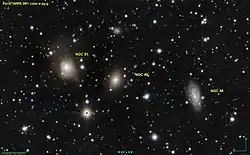| NGC 49 | |
|---|---|
 Pan-STARRS image of NGC 49 | |
| Observation data (J2000 epoch) | |
| Constellation | Andromeda |
| Right ascension | 00h 14m 22.4s[1] |
| Declination | +48° 14′ 48″[1] |
| Redshift | 0.015924[1] |
| Heliocentric radial velocity | (+4774 ± 24) km/s[1] |
| Distance | 225 ± 16 Mly (69.0 ± 4.9 Mpc) |
| Apparent magnitude (V) | +14.1[2] |
| Apparent magnitude (B) | +15.1[2] |
| Characteristics | |
| Type | S0?[1] |
| Apparent size (V) | 1.1′ × 1.0′[1] |
| Other designations | |
| CGCG 549-029, MCG+08-01-033, PGC 952, UGC 136 | |
NGC 49 is a lenticular galaxy in the Andromeda constellation. The galaxy was discovered by the American astronomer Lewis A. Swift on September 7, 1885.[3]
References
- 1 2 3 4 5 6 NASA/IPAC Extragalactic Database
- 1 2 Students for the Exploration and Development of Space
- ↑ Seligman, Courtney. "NGC 49 (= PGC 952)". Celestial Atlas. Retrieved 3 October 2018.
External links
 Media related to NGC 49 at Wikimedia Commons
Media related to NGC 49 at Wikimedia Commons
This article is issued from Wikipedia. The text is licensed under Creative Commons - Attribution - Sharealike. Additional terms may apply for the media files.